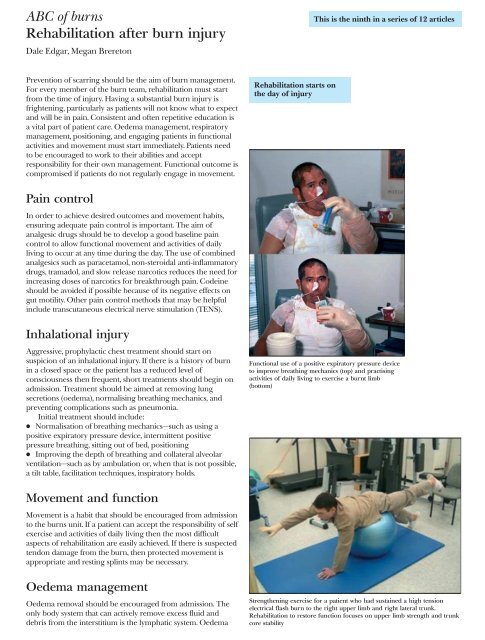ABC of Burns
You also want an ePaper? Increase the reach of your titles
YUMPU automatically turns print PDFs into web optimized ePapers that Google loves.
<strong>ABC</strong> <strong>of</strong> burns<br />
Rehabilitation after burn injury<br />
Dale Edgar, Megan Brereton<br />
This is the ninth in a series <strong>of</strong> 12 articles<br />
Prevention <strong>of</strong> scarring should be the aim <strong>of</strong> burn management.<br />
For every member <strong>of</strong> the burn team, rehabilitation must start<br />
from the time <strong>of</strong> injury. Having a substantial burn injury is<br />
frightening, particularly as patients will not know what to expect<br />
and will be in pain. Consistent and <strong>of</strong>ten repetitive education is<br />
a vital part <strong>of</strong> patient care. Oedema management, respiratory<br />
management, positioning, and engaging patients in functional<br />
activities and movement must start immediately. Patients need<br />
to be encouraged to work to their abilities and accept<br />
responsibility for their own management. Functional outcome is<br />
compromised if patients do not regularly engage in movement.<br />
Rehabilitation starts on<br />
the day <strong>of</strong> injury<br />
Pain control<br />
In order to achieve desired outcomes and movement habits,<br />
ensuring adequate pain control is important. The aim <strong>of</strong><br />
analgesic drugs should be to develop a good baseline pain<br />
control to allow functional movement and activities <strong>of</strong> daily<br />
living to occur at any time during the day. The use <strong>of</strong> combined<br />
analgesics such as paracetamol, non-steroidal anti-inflammatory<br />
drugs, tramadol, and slow release narcotics reduces the need for<br />
increasing doses <strong>of</strong> narcotics for breakthrough pain. Codeine<br />
should be avoided if possible because <strong>of</strong> its negative effects on<br />
gut motility. Other pain control methods that may be helpful<br />
include transcutaneous electrical nerve stimulation (TENS).<br />
Inhalational injury<br />
Aggressive, prophylactic chest treatment should start on<br />
suspicion <strong>of</strong> an inhalational injury. If there is a history <strong>of</strong> burn<br />
in a closed space or the patient has a reduced level <strong>of</strong><br />
consciousness then frequent, short treatments should begin on<br />
admission. Treatment should be aimed at removing lung<br />
secretions (oedema), normalising breathing mechanics, and<br />
preventing complications such as pneumonia.<br />
Initial treatment should include:<br />
x Normalisation <strong>of</strong> breathing mechanics—such as using a<br />
positive expiratory pressure device, intermittent positive<br />
pressure breathing, sitting out <strong>of</strong> bed, positioning<br />
x Improving the depth <strong>of</strong> breathing and collateral alveolar<br />
ventilation—such as by ambulation or, when that is not possible,<br />
a tilt table, facilitation techniques, inspiratory holds.<br />
Functional use <strong>of</strong> a positive expiratory pressure device<br />
to improve breathing mechanics (top) and practising<br />
activities <strong>of</strong> daily living to exercise a burnt limb<br />
(bottom)<br />
Movement and function<br />
Movement is a habit that should be encouraged from admission<br />
to the burns unit. If a patient can accept the responsibility <strong>of</strong> self<br />
exercise and activities <strong>of</strong> daily living then the most difficult<br />
aspects <strong>of</strong> rehabilitation are easily achieved. If there is suspected<br />
tendon damage from the burn, then protected movement is<br />
appropriate and resting splints may be necessary.<br />
Oedema management<br />
Oedema removal should be encouraged from admission. The<br />
only body system that can actively remove excess fluid and<br />
debris from the interstitium is the lymphatic system. Oedema<br />
Strengthening exercise for a patient who had sustained a high tension<br />
electrical flash burn to the right upper limb and right lateral trunk.<br />
Rehabilitation to restore function focuses on upper limb strength and trunk<br />
core stability



